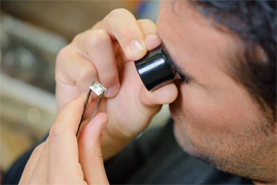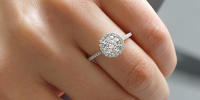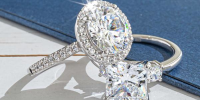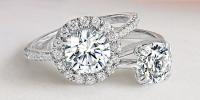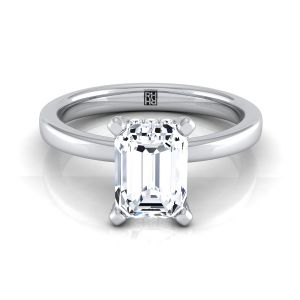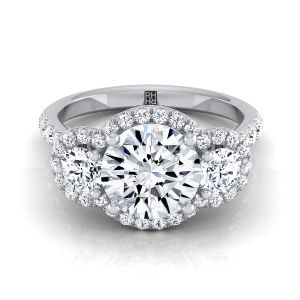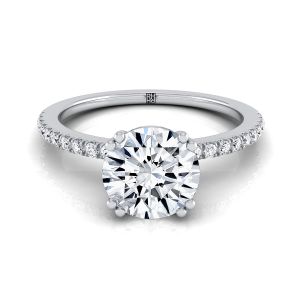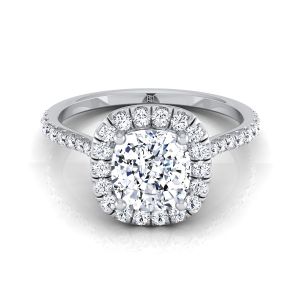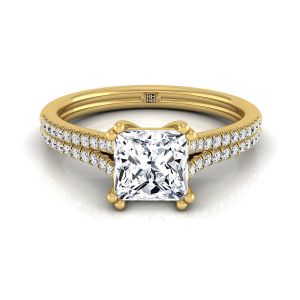 You can’t. There are two reasons why. First, a carat is one-fifth of a gram. The difference here is just one-hundredth of a gram, which is tiny. And second, what matters most to you is size, not really weight.
You can’t. There are two reasons why. First, a carat is one-fifth of a gram. The difference here is just one-hundredth of a gram, which is tiny. And second, what matters most to you is size, not really weight.
Carat Weight & Diamond Diameters
Of course, weight is related to size. But the main dimension that you notice when you are looking at the diamond in your ring is the diamond’s face-up diameter. And what’s really surprising is that diamonds of the exact same weight often have different diameters! In fact, you can find one-carat diamonds with a diameter of 6.1mm and one-carat diamonds with diameters of 6.5 mm. In fact, a 0.95-carat diamond could have the exact same diameter as a one-carat diamond. RockHer has 0.95-carat diamonds that have a diameter of 6.3mm and one-carat diamonds that have a diameter of 6.3mm. They look exactly the same size in a ring because they are exactly the same size. You can’t see the depth of a diamond when it’s set in a ring.Weight Catagories & Why They Matter
So if two diamonds are the same size face up, how can one be 20% less in price? It has to do with the way diamond pricing works. Diamonds are sold by weight and all prices are calculated per carat. So, for example, a 0.50 carat diamond that costs $2000 per carat will cost $1000 for the stone: $2000 x 0.50 = $1000. A 1.50-carat diamond that is $5000 per carat will cost $7500, and so on. The price per carat of any diamond increases as its weight category increases. That’s because every diamond price list is based on weight categories. So the more a diamond weighs, the more per carat it will cost. However, prices don’t go up in a smooth gradual curve, they increase in stair steps. Price categories include 0.50 to 0.69 carats, 0.70 to 0.89 carats, 0.90 to 0.99 carat, 1.00 to 1.49 carat, and 1.50 to 1.99 carat. The price difference for higher weight categories can be significant. The per carat price of diamonds jumps noticeably when the weight crosses the line between price categories. The price per carat jumps when you go from .89 carats to 0.90 carats and then jumps again, even more, when you go from 0.99 carats to 1.00 carat.
That’s why a 0.99-carat diamond is worth only about 1% more than a similar diamond weighing 0.98-carat. But a 1.00-carat diamond is worth 10% to 20% more than a similar 0.99-carat diamond!
The per carat price of diamonds jumps noticeably when the weight crosses the line between price categories. The price per carat jumps when you go from .89 carats to 0.90 carats and then jumps again, even more, when you go from 0.99 carats to 1.00 carat.
That’s why a 0.99-carat diamond is worth only about 1% more than a similar diamond weighing 0.98-carat. But a 1.00-carat diamond is worth 10% to 20% more than a similar 0.99-carat diamond!
Carats & Cut Quality
There is another reason why it’s much better to buy diamonds that fall just below a price category jump. Imagine you are a diamond cutter who has a rough diamond that will cut a beautifully proportioned 0.99-carat diamond. If you compromise a bit on the quality, you can make sure it weighs 1.00 carat. And honestly, you can probably do that for a 0.97-carat diamond too by compromising a little bit more. If you don’t care at all about cut quality, you can do this with a piece of rough that would cut a 0.85-carat ideal cut. Hey, it’s business! This is a smart way for cutters to make the most possible money from that rough. This kind of profit-maximizing, by paying attention to weight categories, is routine in big diamond cutting factories. It means that 1.00-carat diamonds (and 1.01 and 1.02 carat) that are cut for weight not beauty, won’t be as brilliant as properly cut diamonds. That means there are a lot of one-carat diamonds out there that you really don't want to buy. They are not beautiful diamonds. And you want a beautiful diamond, right?Margins & the Mass Market
It’s even worse when you buy diamonds already set in jewelry from big retailers. When mass retailers offer one-carat diamonds the fine print says that weights may vary from 0.95 to 1.10 carat. That means a big retailer can sell you a 0.95-carat diamond in a ring as a “one-carat diamond,” taking that weight category price difference as profit for themselves. (And since the diamonds sold at these retailers don’t have GIA or AGS certs with cut grades, they don't have to be well cut either: they can be that 0.80-carat example above.) This is one of the most important reasons that you should buy a loose diamond, not one already set into an engagement ring.The Sweet Spot for Diamond Weight
Thanks to smart shoppers and all the retailers looking for extra margin, it can be difficult to find loose diamonds that fall just under the 1.00-carat mark. That’s why ROSI, RockHer’s diamond-picking AI powered by IBM’s Watson who analyzes the prices, quality, and value of thousands and thousands of diamonds every day, recommends the magical 0.95-carat diamond. It’s far enough away from the 1.00-carat boundary that you can find a well cut and well-proportioned stone with exceptional brilliance and scintillation. No one but you will know that it’s slightly less than a carat. All everyone will see is that it’s a beautiful diamond. ROSI also looks for diamonds with a larger diameter, no distracting fluorescence, good color and clarity, and an excellent or very good cut. After all, you don’t just want a diamond that is cheaper. You want a diamond that’s a better value and that’s more beautiful too. %%%FY80103HIVS-CU125RH , FW80071HIVS-RD125RH , FW80079HIVS-RD125RH%%%










